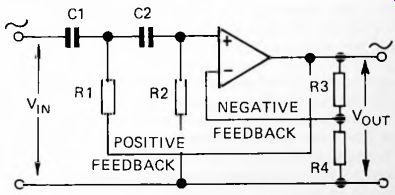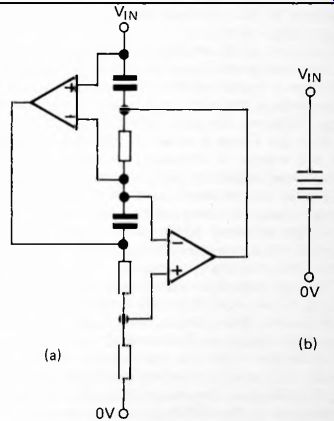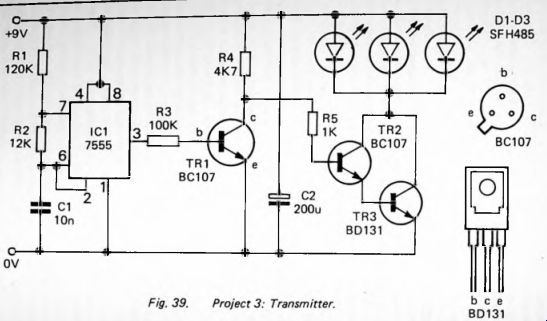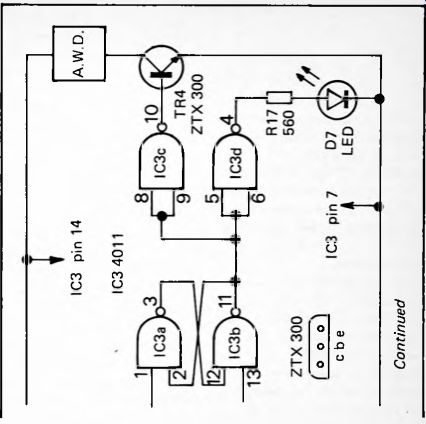AMAZON multi-meters discounts AMAZON oscilloscope discounts
In Section 3 we saw how a low-pass passive filter may be converted into a high-pass filter simply by exchanging the resistors and capacitors. Figures 16 and 17 illustrate this point for second-order passive filters. An active low-pass filter is converted into its equivalent high-pass version by employing the same procedure. For example, the second-order low-pass section of Figure 31 becomes the high-pass section shown in Figure 37. Note that only the resistor-capacitor networks of the section are involved in the exchange.
The two resistors in the negative feedback loop naturally remain as resistors since they constitute the potential divider which determines the amount of feedback.

Fig. 37. 2nd order high-pass section.
The operation of the high-pass filter is the converse of that of the low-pass filter, described on page 35. At high frequencies the capacitors pass the signal directly to the op amp. It is amplified according to the relative values of R3 and R4 and finally appears at the output. At low frequencies the capacitors block the passage of the signal to the amplifier.
Instead, the signal is partly routed through R1 to the output side of the amplifier and partly through R2 to the ground line.
The low-frequency signal going to the ground line is lost. The signal coming through R1 is largely cancelled owing to the effect of negative feedback. At both high and low frequencies the section behaves in much the same way as a second-order passive filter, except that amplification may restore or enhance the signal level. As in the low-pass filter of Figure 31, there is strong positive feedback around the cut-off frequency. Resonance occurs, giving an upward thrust to the response curve.
In this way the operational amplifier is made to produce the same sharpening of the knee of the curve as would be obtained by using an inductor.
Apart from filtering out low frequencies instead of high frequencies, high-pass filters have very similar properties to their low-pass counterparts. The frequency of the cut-off point is given by the equation / = 1/ pi RC. The roll-off in the stop-band is +6dB for a first order section and +12dB per octave for a second order section. The positive sign indicates that V_out/V_in increases with increase of frequency. First-order and second-order sections may be combined to produce filters of higher orders. Finally, by suitable choice of capacitor values we may build filters with a range of responses such as Butterworth, Chebyshev, Bessel and others. But there is one difference due to the nature of operational amplifiers.
The gain of an op amp falls off when frequency is in excess of a given level. This is because voltage levels and currents in an amplifier can never change instantaneously. Every thing takes time to happen. Consequently there is a limit to the rate at which the output voltage can rise and fall. The higher the frequency, the lower the amplitude attainable.
Different types of op amp differ in this respect, but in most of them gain begins to drop when frequency is in excess of a few tens of kilohertz. The pass-band response is flat until this limit is reached. Above this limit, output begins to fall at about -6dB per octave. Thus an active high-pass filter, if operated at frequencies of tens of kilohertz becomes, in effect, a band pass filter. We deal with filters that are specifically designed as band-pass Filters in the next section. Here we simply note this effect as a possible shortcoming of high-pass active Filters based on op amps.
Having dealt with the main topic of this section in a relatively short space we now consider a different way of building active filters using op amps.
Frequency-dependent Negative Resistors
An FDNR, as it is more conveniently known, is a sub-circuit which behaves as if it has negative resistance. The value of its negative resistance depends on the frequency of the signal that is being applied to it. Obviously such a sub-circuit could have applications in filtering.

Fig.
38. (a) (b) A gyrator connected to form an FDNR or "double capacitor";
the "double
capacitor" symbol.
The FDNR is one of several variants on a type of sub-circuit known as a gyrator. As Figure 38 shows, a gyrator consists of two op amps taking their inputs from and supplying their outputs to a chain of five elements, usually resistors and capacitors. Each op amp feeds its output through this chain to the inputs of the other op amp. Their interactions run round and round in circles, hence the name gyrator. An element in the chain can be any device that has reactance but, if the first and third elements are capacitors and the others are resistors, we have a sub-circuit with the property of negative resistance. As might be expected, the swings of voltage and current in this sub-circuit are complex and we shall not attempt an explanation here.
The output of the interaction between the op-amps and their associated passive components is that, when an alternating voltage is applied at the VIN terminal, the alternating current flowing into that terminal is out of phase with the voltage. Moreover, the phase difference is 180°. This means that when the voltage is increasing, the current is decreasing; when the voltage is decreasing, the current is increasing.
Although the individual parts of the sub-circuit all obey Ohm's Law, the sub-circuit as a whole acts in this unusual way, equivalent to it having negative resistance.
Since the behavior of the sub-circuit depends on several changes of phase internally, brought about by the capacitors and the inverting action of the op amps, we might expect that negative resistance varies with frequency. Negative resistance is low when frequency is high and high when frequency is low. The sub-circuit acts similarly to a capacitor, passing high frequencies and blocking low frequencies (page 8). However, there are quantitative differences. The reactance of a capacitor is inversely proportional to frequency; halving the frequency doubles the reactance. Because the reactance of the FDNR is inversely proportional to the square of the frequency, halving the frequency quadruples the reactance. So the FDNR has a stronger action than the capacitor. Furthermore, whereas the phase change with a capacitor is 90°, the phase change with an FDNR is 180°. For these two reasons, FDNRs are often referred to as 'super-capacitors'. This is reflected in the symbol used to represent FDNRs in circuit diagrams (Fig.38(b)).
The properties of FDNRs lend themselves to the production of filters with flat pass-bands and precisely determined phase response. In addition, component tolerances have relatively little effect on the behavior of the sub-circuit. For these and other reasons FDNR Filters are becoming popular, especially in instrumentation where high-quality reproducible filtering is essential.
PROJECT 3--Infra-red Intruder Detector
Although this project was designed for detecting intruders, it has many other uses as a domestic 'watchdog'. It can check that toddlers have not wandered out through the open back door; it can check that a likely sleep-walker has not strayed from their bedroom; it can make sure that the cat has come in; it can watch for the postman.
Level 2--How It Works
The device depends upon the familiar 'broken beam' principle but with the refinement that the beam is pulsed. The transmitter produces 1000 pulses a second, but each pulse lasts only for 0.1ms. In other words the 'duty cycle' is 0.1.
The infra-red LEDs are switched on for only 10% of the time. This means that they can be made to carry a very heavy current during that short period, emitting short but intense pulses of infra-red. This gives the transmitter a very much longer range than would be obtainable with a continuously emitted beam. It also means that power consumption is only one-tenth of what it would otherwise be. In the transmitter there are three LEDs wired in parallel and each carries a current of about 660mA when switched on. This gives a total current requirement of 2A when the LEDs are on, but an average current of only 200mA.

Fig. 39
The other benefit of using a pulsed beam is that the receiver can be designed to respond only to a pulsed signal.
This means not only that the alarm sounds when the beam is broken, but also that the alarm sounds if any attempt is made to saturate the sensor by shining a bright light on it. Since the system operates with infra-red, it makes it impossible for the intruder to see the beam and avoid it, even in total darkness. Indeed, an intruder shining a flashlight around the room is very likely to trigger off the alarm without even stepping through the beam.
The transmitter (Fig. 39) is based on a timer IC which produces a signal at 1kHz, with a duty cycle of 0.9. The output of the timer is high for approximately 0.9ms and low for 0.1ms. This signal is inverted by TR1 to convert the duty cycle to 0.1. The signal is then fed to TR2 and TR3 connected as a Darlington pair to give the high gain required to switch the infra-red diodes on and off. TR3 is a medium-power transistor, able to carry the heavy peak current required. In order to meet the sudden demand for a large current every time the LEDs are switched on, a high-value electrolytic capacitor C2 is wired between the power lines.
This accumulates charge while the LEDs are off, ready for the relatively short period during which the current is required.
The receiver (Fig. 40) uses an infra-red photodiode D4 as its sensor. The diode is reverse-biased and only a small leakage current flows. The amount of leakage current is proportional to the amount of illumination reaching the diode. As the leakage current flows through R6, a potential difference is generated across it. Thus the received signal appears as a pulsed voltage, which passes through R9 to the operational amplifier IC2a. This has a gain of 330, giving an amplified signal which is then filtered by the high-pass filter based on IC2b. The values of C3, C4, R11 and R12 are chosen to give a cut-off point at about 800Hz. The reason for using a high-pass filter is that the signal may be subject to changes at low frequency.
There may be variations in the amount of light (both visible and infra-red) reaching the photodiode from sources other than the transmitter. For example, closing the curtains at dusk causes a sudden reduction of light level which affects the sensor. This is a slow (low frequency) change which, though it affects voltage level at the output of the amplifier, has no effect at all on the output of the filter. There is also the problem of the 50Hz signal emitted by mains-powered lamps. In addition it is possible for 50Hz mains interference from other equipment in the room to be picked up and amplified by the circuit. Signals at 50Hz from whatever source are removed by the high-pass filter.


Fig. 40
The filtered signal now passes across C5 to a diode pump.
This is a sub-circuit which responds only to a pulsed signal.
Like most water-pumps and air-pumps it has two 'valves', the two diodes D5 and D6. As the potential at C5 increases, current flows through D6 and charges capacitor C6. As the potential at C5 falls, current passes from the 0-V line through D5 to prevent the potential at C5 from falling. Thus, every time a pulse appears at C5 an additional charge is built up on (or pumped into) C6. The charge can leak slowly through R15 but, as long as a continuous stream of pulses is arriving, the charge is maintained. This gives the equivalent of a high logic level at the input of the NAND gate, IC3a. If the infra-red beam is interrupted, or if the sensor is saturated by shining a bright light on it, the output from the filter is no longer pulsing. There is no pumping action and C6 discharges through R15. The input to the NAND gate falls to logical low. IC3a and IC3b form a set-reset bistable. The bistable is reset by pressing S1. This causes the output of lC3b to go high. IC3c and IC3d act as INVERT gates, so their outputs are at logic low No current flows to the indicator LED D7 and TR4 is off. The audible warning device (AWD) is silent.
When the beam is broken or the sensor is saturated, the low level across C6 causes the bistable to become set. The output of IC3b goes low, and the outputs of IC3c and IC3d go high, switching on the LED and the AWD. Once this has happened the bistable remains set indefinitely, even if the beam is restored, so the alarm continues to sound. It is silenced only by pressing S1, after restoring the unbroken beam.
Construction
The transmitter and receiver are usually housed in separate enclosures. If only a narrow corridor or doorway is to be protected it is possible to have both sections of the circuit in the same enclosure with a mirror opposite to reflect the beam back to the sensor. The transmitter requires approximately 200mA so, unless it is to be used for only an hour or so at a time, it is best powered by a 9V d.c. mains adaptor. The receiver requires about 10mA and can be powered by a battery of four 'D' type cells or a 'bell battery'. Alternatively, it can be powered from the same source as the transmitter.
Before beginning construction, some thought must be given to where the transmitter and receiver are to be mounted.
It is much better if both can be concealed from sight, perhaps by being built into existing furniture or cupboards. It may even be possible to disguise one or both units as 'books' on a conveniently sited bookshelf. Use can also be made of window curtains to partly hide them. If a doorway is being protected, locate the units so that they can not be seen until the intruder has actually entered the room. The receiver must be mounted so that it does not receive bright light, either from direct sunlight or from a bright sky, for this would permanently saturate the sensor. If the field of view of the sensor is restricted by placing it at the rear of a narrow tube with a matt black interior, there is less interference from ambient lighting. The range of the receiver is 2m-3m, which is enough for protecting a doorway, a corridor, a hallway or a small room. Range can be extended by increasing the number of diodes in the transmitter to four. Alternatively, increase the range by placing a lens in front of the sensor to focus a larger proportion of the beam on to it. A cheap magnifier of glass or plastic is suitable; better are the inexpensive red plastic lenses specially intended for focusing infra-red. This is yet another way of reducing interference from other sources of illumination.
Another point to consider is the nature of the audible warning device. A wide range of solid-state devices are available, ranging from small pcb-mounting bleepers to weatherproof sirens suitable for mounting on the outside wall of the house. Many of the sirens require a surprisingly small current (about 20mA) for the volume of sound produced. For a security system it is usually better to install a loud siren and to mount this at some distance from the protected area, preferably in some inaccessible place. Try to conceal the wiring as far as possible. For some of the more domestic purposes mentioned earlier, a low-volume bleeper is preferable. Some of these produce a continuous note, but those that produce a warbling or intermittent sound are usually more effective in gaining attention. Depending on the application these may be mounted on the same pcb or stripboard as the receiver circuit.
When the transmitter is operating, the metal tab of TR3 becomes hot to the touch. It is preferable to fit a clip-on heat sink to this transistor. Mount the three LEDs so that they are side by side and aligned in the same direction. It is sometimes possible to check the circuit by seeing that each LED glows a dull red in the dark. Otherwise, connect a voltmeter to measure the voltage at the collector terminal of TR3. This gives a reading of about 7V, showing a voltage drop of 2V across the LEDs.
Note that D4 is connected so as to be reverse-biased, with its cathode (k) positive. The early stages of the receiver can be checked using an oscilloscope. The signal can be monitored at the anode of D4, and (inverted) at the output of IC2a. Both of these signals show the pulses superimposed upon a d.c. voltage which varies with the total intensity of illumination falling on D4. The signal at the output of IC2b shows only the pulsed waveform, though this is not a square wave but a series of negative-going spikes. The remainder of the circuit may be checked without an oscilloscope. The voltage across R15 rises to about 4V when the signal is being received and falls almost to 0-V when the beam is broken.
When testing and setting up the circuit, it is best if the AWD is not connected. Instead we rely on D7 to indicate whether or not the bistable has been triggered. With the transmitter switched on and aimed at the sensor, D7 goes out and stays out when S1 is pressed and released. Breaking the beam, or shining a torchlight on to the sensor immediately triggers the circuit and D7 comes on. Once the transmitter and receiver have been aligned for correct action, the AWD may be connected into the circuit for final testing. If the circuit is to be used in circumstances in which the transmitter and receiver may frequently need re-alignment, fit a switch between the positive line and the positive terminal of the AWD, so that it may be temporarily inactivated.
Special Components
Semiconductors:
D1-D3
SFH485 Ga-Al-As infrared emitter diodes (3 off).
These are high-intensity diodes with medium beam angle (40°); similar though slightly less powerful types such as TIL38 may be used.
TIL100 photodiode (or similar)
1N4148 silicon signal diode
D4 D5,D6
TR1-TR2
BC107 npn low-power transistor (2 off)
BD131 npn medium-power transistor ZTX300 npn medium-power transistor
TR3 TR4
Integrated Circuits
IC1 7555 CMOS timer
IC2 LF353 dual JFET operational amplifier
4011 CMOS quadruple 2-input NAND gate
IC3